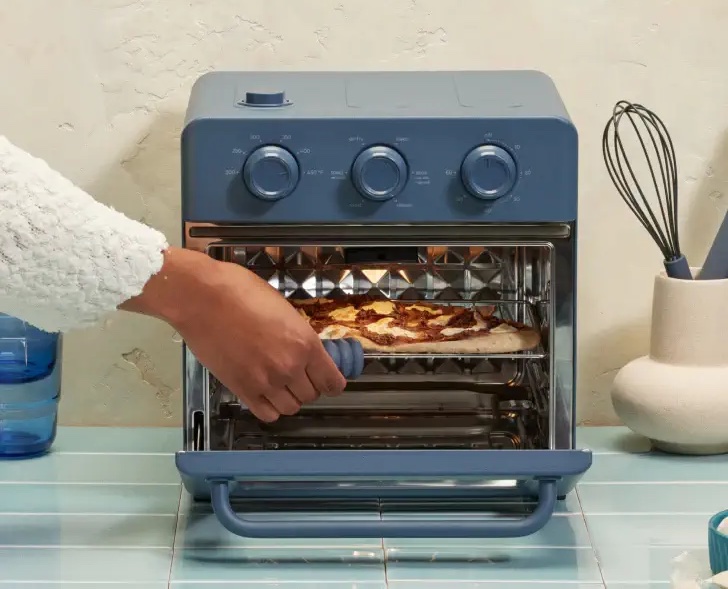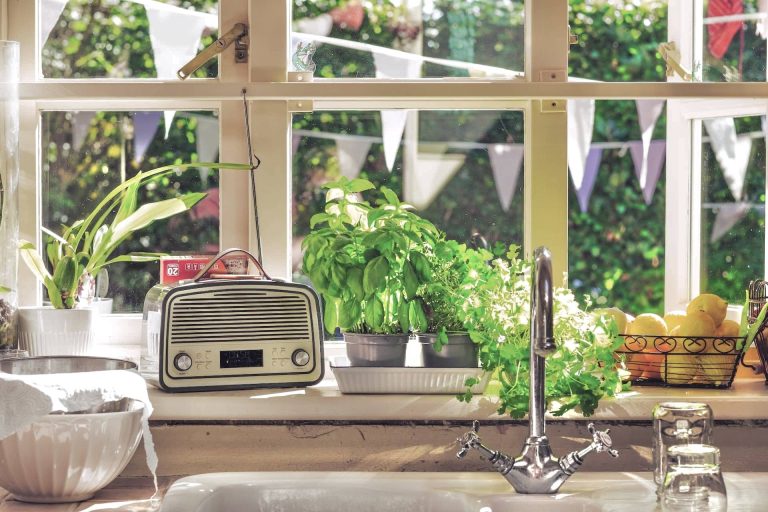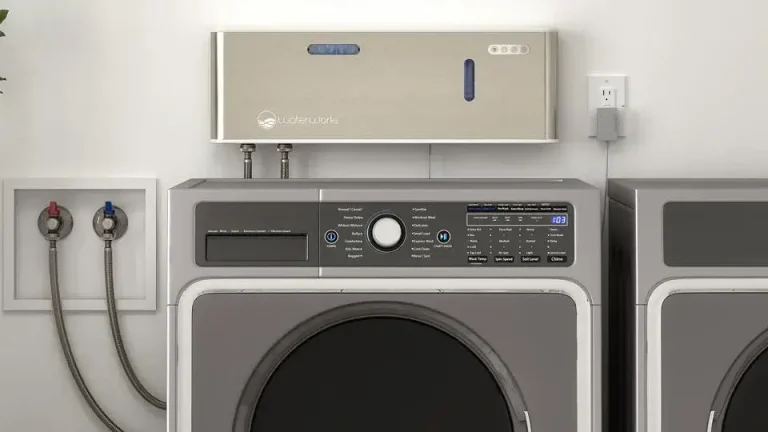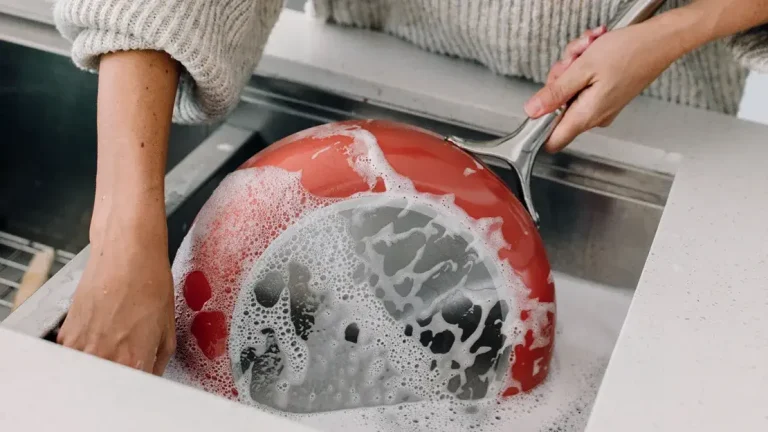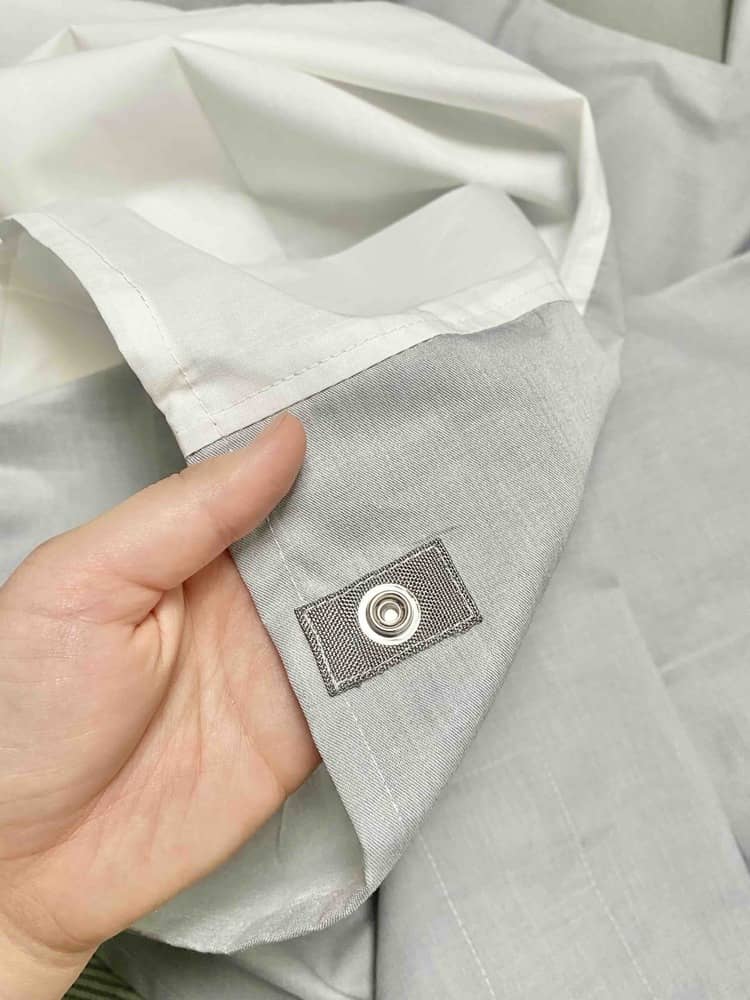6 Best Nontoxic Cutting Boards In 2024 (Ranked for Usability, Quality, and Durability)
Ever since the news got out that plastic cutting boards could be dirtier than a toilet seat, people have been thinking twice about their humble chopping blocks. Could they really be more dirty than their porcelain thrones?
They began to second guess themselves, observing their beat, cut-up plastic boards for what seemed like the first time, asking questions like How long have I actually been using this thing?
“In most cases, it’s safer to make a salad on a toilet seat than it is to make one on a cutting board.”
Dr. Charles Gerba (a.k.a. Dr. Germ), a microbiologist and professor at the University of Arizona in Tucson
With more and more reports surfacing on the potential health risks of using plastic cutting boards, including BPA and microplastics, many people are now looking for alternative nontoxic options that are not only safe but also durable, sustainable, and high-quality. It’s one of the first things you should swap for a non toxic kitchen.
What Are the Safest Non-Toxic Cutting Boards?
The safest and best nontoxic cutting boards come in natural wood, organic bamboo, and natural rubber.
Each material has its own unique benefits and drawbacks, but overall they are much healthier than plastic cutting boards.
Here are six of the best nontoxic cutting boards that you can consider purchasing in 2024:
Our Top Picks:
- Best Overall Cutting Board
- Best Budget Non Toxic Cutting Board (Under $35)
- Best Looking Cutting Board:
- Best Compact & Lightweight Cutting Board:
- Best Heavy-Duty Cutting Board for Serious Chopping
- Best Low-Maintenance Cutting Board
Best Overall Cutting Board: MIYABI Cutting board, Hinoki, Large
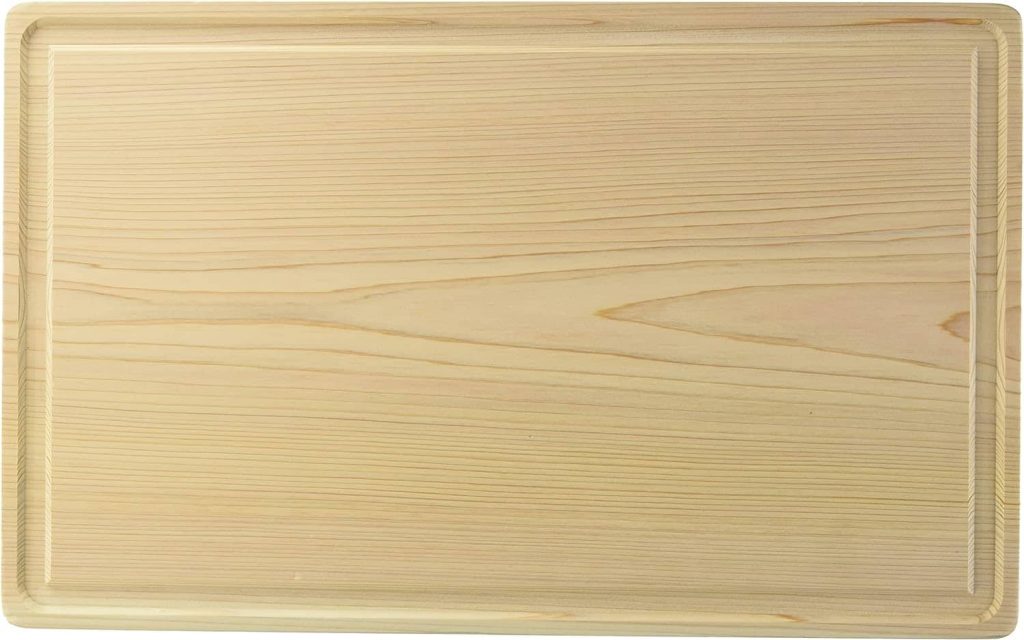
Key Benefits
- Hinoki is a native Japanese cypress with a wonderful natural fragrance – naturally antibacterial, anti-microbial, antifungal, and mold-resistant.
- Is prized to be the best wood for preserving the sharpness of their knives (it’s the cutting board of choice for sushi chefs!)
- Lightweight yet durable for everyday use – perfect for both professional chefs and home cooks. It weighs up to 1/3 less than popular American woods like cherry, walnut, or maple.
- Made from a single slab of hinoki wood – contains no additives or formaldehyde-containing glues
- Finished with natural beeswax – no toxic finishes or sealants added
- Its high natural oil content inhibits odor absorption
- The top choice for longevity: highly resistant to wear and tear, warp and crack resistant
- Made in Seki, Japan
Pricing
$116.15
Personal Opinion
If you’ve ever walked into a sushi restaurant in Japan, you’ll recognize the unmistakable, fragrant aroma of hinoki wood. And if you’ve had the pleasure of using a hinoki cutting board, you won’t want to go back to a traditional one again. Unlike other wooden cutting boards which I’ve found clunky and heavy, this one weighs up to a third less – which you’ll definitely appreciate when you maneuver from your counter to stovetop with ease. When paired with Japanese knives – you’ll feel a bit like a real sushi chef!
While the MIYABI board may not be the cheapest option on the market, the quality and longevity of this cutting board make it well worth the investment.
Best Budget Nontoxic Cutting Board: Greener Chef Extra Large Bamboo Cutting Board
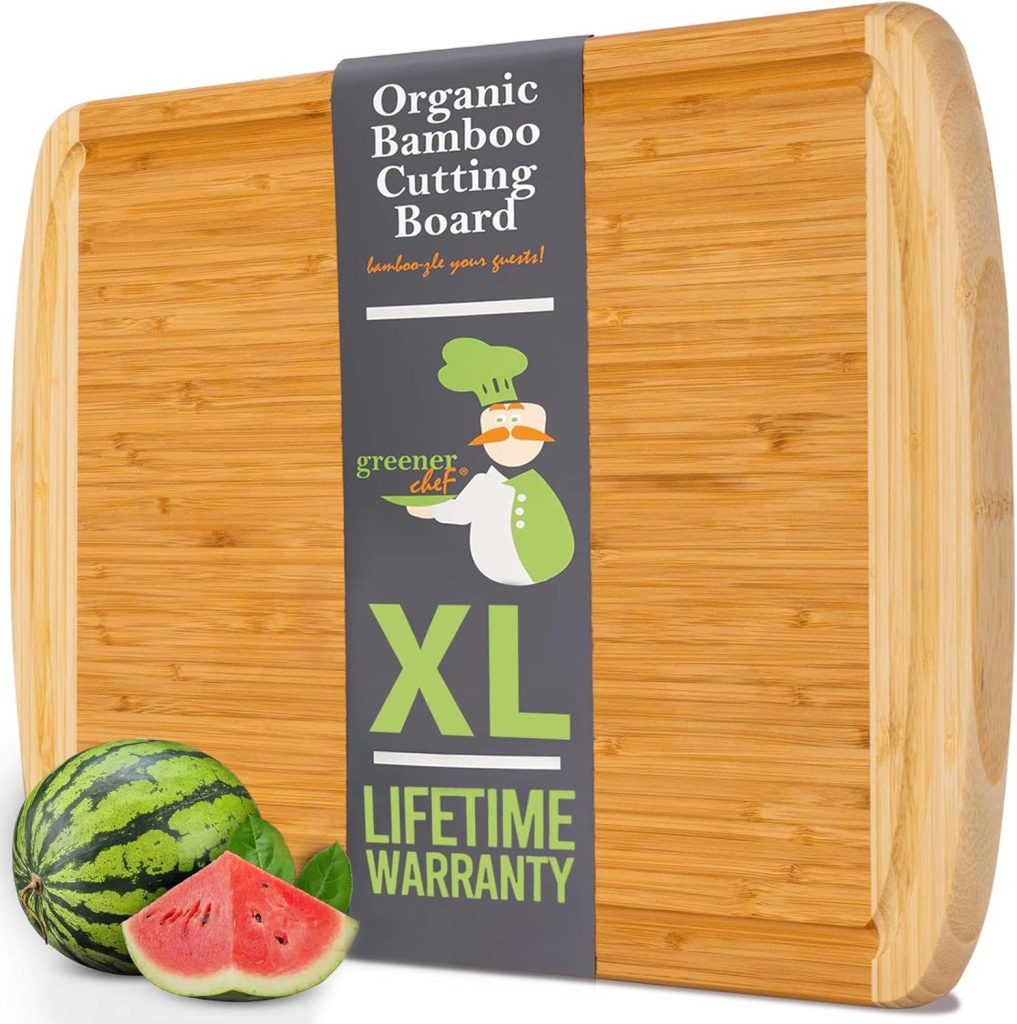
Key Benefits
- 100% organic moso bamboo – one of the most hardy and fastest-growing varieties of bamboo
- Unlike many bamboo boards, this board is long-lasting and even comes with a lifetime replacement warranty
- Non-porous and chemical-free
- Sustainably and ethically sourced
- Won’t dull your knives
- Won’t warp, split, or crack
- Water, stain, and scar-resistant – wipes down easily
- Deep juice grooves so you don’t make a mess
- Extremely lightweight
- Double-sided, can also be used as a serving tray
Pricing
$34.99
Personal Opinion
This cutting board is an incredible value for its price. Not only is it made without the use of any chemicals or formaldehyde-containing glues that are present in many cutting boards, but the Greener Chef is also made from only organic, responsibly sourced bamboo. Bamboo is one of the most renewable resources on earth, growing up to three feet per day! The deep juice grooves help contain messes and the lightweight design makes it easy to move from counter to sink or stovetop. Plus, the lifetime replacement warranty ensures that you won’t have to buy another cutting board again. For those looking for the perfect combination of quality, sustainability, and affordability – this one’s a no-brainer!
Best Looking Cutting Board: Ziruma End Grain Teak Butcher Block
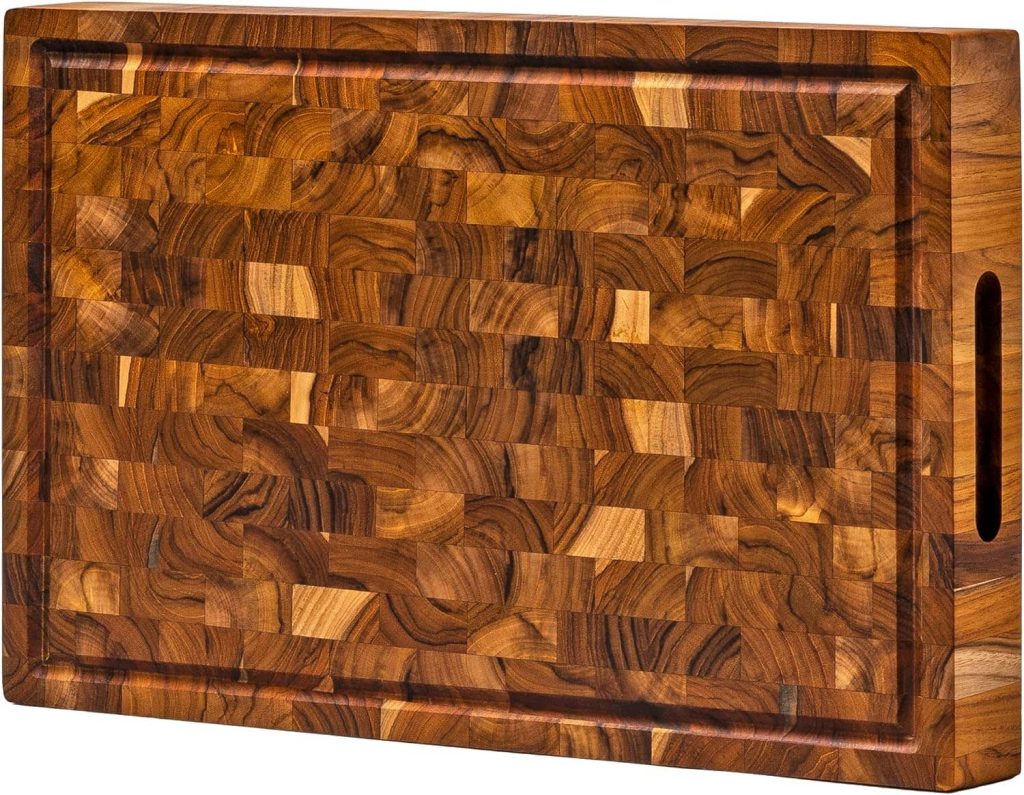
Key Benefits
- Teak is the most prized naturally antibacterial wood in the world, and resistant to moisture, bacteria, warping, and splitting
- Conditioned with beeswax, linseed & lemon oil
- Free of BPA, mineral oils, phthalates, and formaldehyde
- 1.5 inches thick – it’s hefty, durable, and sturdy
- End grain surface “gives” to knives, making them resistant to scarring
- Gorgeous enough to be a table centerpiece or to use as a beautiful serving tray
- Fantastic customer service
- 100% recyclable and plastic-free packaging
Pricing
$82.50
Personal Opinion
This wood cutting board is absolutely stunning – you’ll notice it from across the room. Its sturdiness and resistance to scarring make it both functional and a true piece of art. On top of that, teak is naturally antimicrobial and durable, ensuring your board lasts you for years. The end-grain surface means that your knives will also stay sharp. The depth of the color in this grain will also make any dish look gourmet and expensive. Everyone will be asking where you got it!
Best Compact & Lightweight Cutting Board: Shun Cutlery Small Hinoki Cutting Board
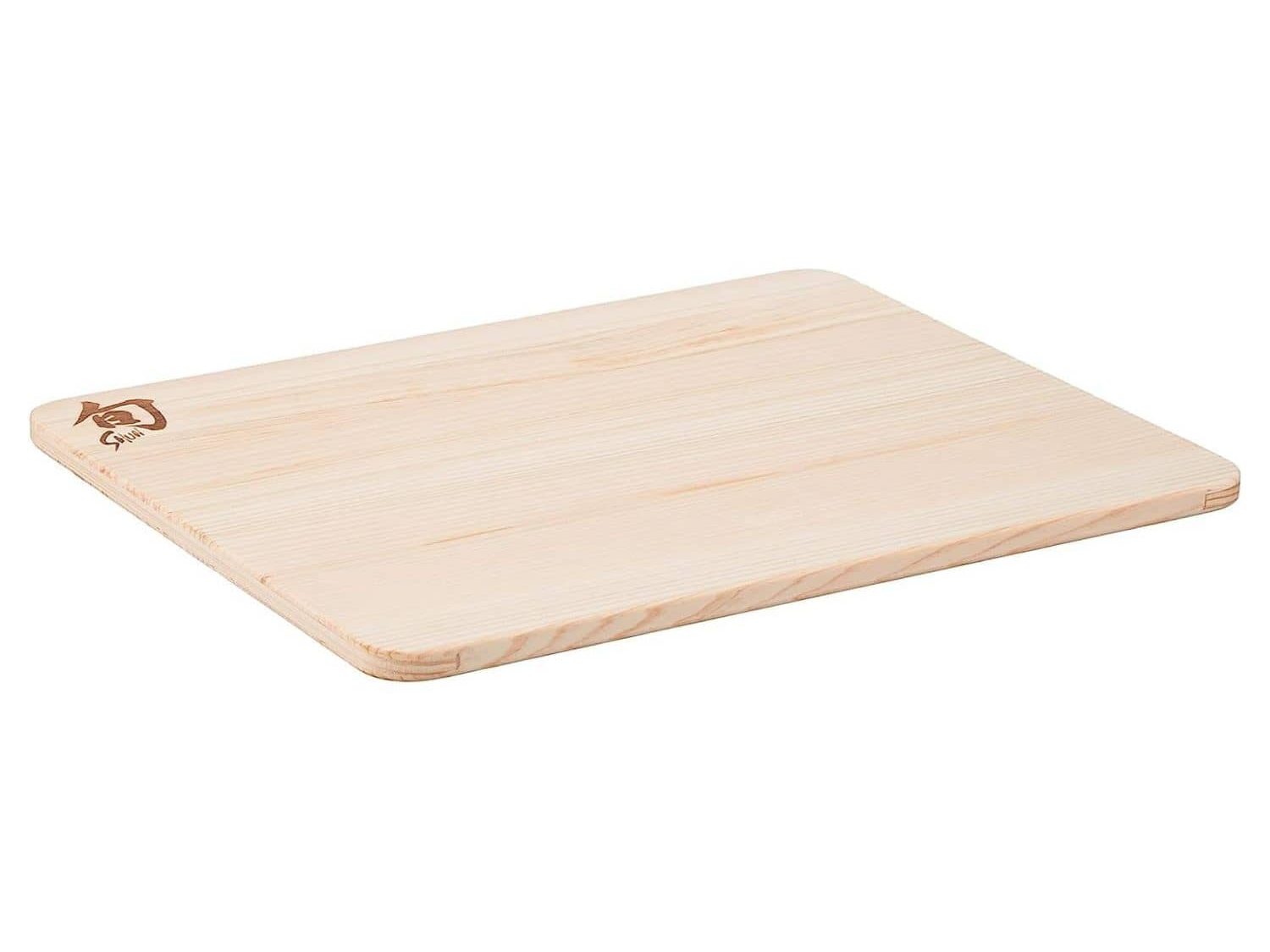
Key Benefits
- Incredibly lightweight, durable, and the perfect size for general tasks. Easy to wash in small sinks and easy to store.
- Hinoki is a native Japanese cypress with a wonderful natural fragrance – naturally antibacterial, anti-microbial, antifungal, and mold-resistant
- Is prized to be the best wood for preserving the sharpness of their knives (it’s the cutting board of choice for sushi chefs!)
- Made from a single slab of hinoki wood – contains no additives or formaldehyde-containing glues
- Its high natural oil content inhibits odor absorption
- Highly resistant to wear and tear, warp and crack resistant
Pricing
$38
Personal Opinion
THIS is the cutting board that you’ll keep coming back to every time you’re in the kitchen. Its durability, compact size, and incredible lightness make it the perfect everyday cutting board for all your kitchen tasks. The fact that it’s made from a single slab of natural hinoki wood without any added glues or chemicals means that this is as clean and natural a surface as you can get for your food. The delicious fragrance of hinoki wood is just an added bonus!
Best Heavy-Duty Cutting Board for Serious Chopping: John Boos Maple Wood Cutting Board for Kitchen Prep
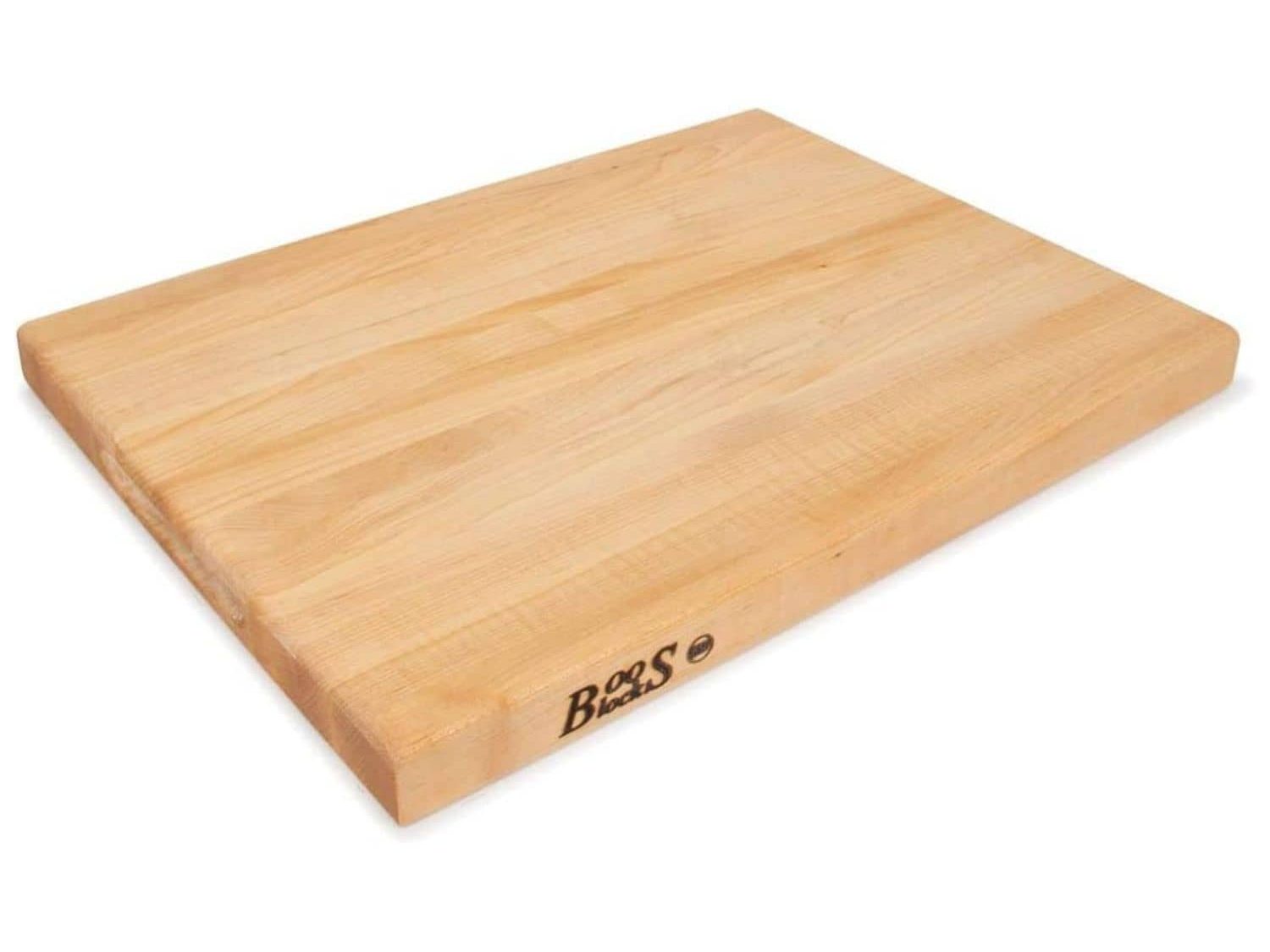
Key Benefits
- Heirloom-quality construction – crafted from hand-selected, sustainably harvested North American hard maple
- Edge grain surface made to withstand heavy-duty chopping tasks
- Designed to meet the demanding expectations of commercial kitchens
- Double-sided – both sides of the board can be used as a cutting surface
- Made in USA
- Exceed the highest level of quality and food safety standards
Pricing
$124.95 (more sizes and prices available)
Personal Opinion
This is not a lightweight cutting board you’ll be picking up and moving around. Its hefty 1.5-inch thickness and solid maple wood construction make it the perfect choice for serious chopping, like breaking down large cuts of meat with a cleaver or cutting through dense root vegetables. The reversible design also adds a layer of convenience, allowing you to use one side for meat and the other for vegetables. Its top-tier quality, durability, and versatility make it well worth the investment for serious home cooks or professional chefs.
Best Low-Maintenance Cutting Board: NoTrax Sani-Tuff T45 Natural Rubber Cutting Board
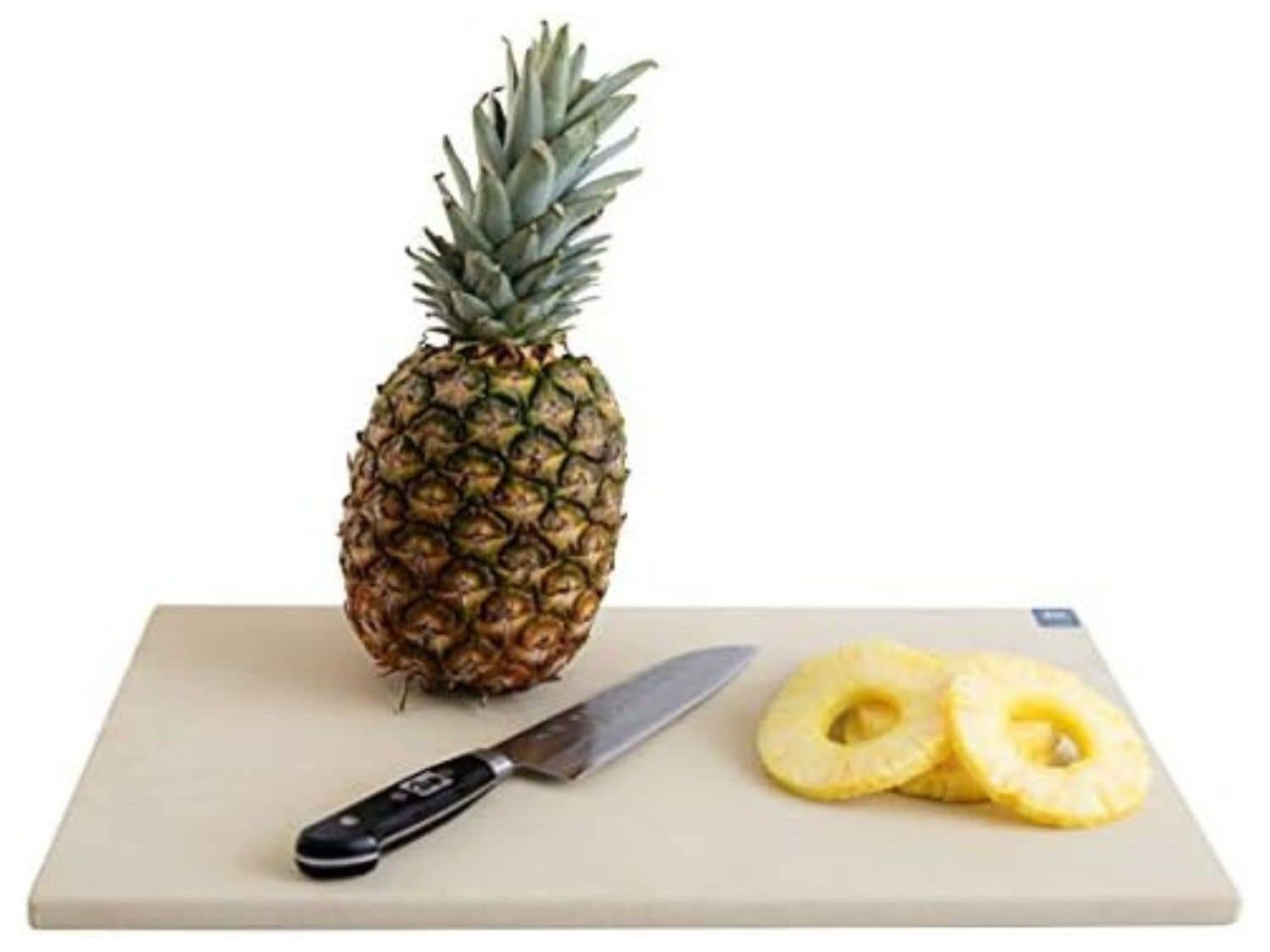
Key Benefits
- Made in USA, 30-day warranty
- Made of 100% NSF (National Sanitation Foundation) certified, natural, high-density rubber. Does not contain any synthetics, dyes, or adhesives.
- Won’t crack, splinter, swell, or absorb liquids or odors
- Preserves your knife blades better than wood
- Naturally anti-slip and grips onto the counter while you chop and slice, preventing dangerous slipping accidents
- Unlike wooden cutting boards, you won’t need to oil them every month
- Dual-sided – use one side for meat and the other for veggies. No need to use separate cutting boards
- Must be hand-washed, not dishwasher safe
Pricing
$89.43
Personal Opinion
If you’re looking for an easy-to-maintain, straightforward nontoxic cutting board that is both durable and safe, this natural rubber cutting board is a great choice. Its all-natural rubber material makes it a hygienic option, as it won’t absorb liquids or odors. This also means that it is gentle on your knives and won’t dull them like wood does. Its anti-slip properties make it a safer choice compared to other cutting boards, as it won’t move around while you’re using it.
What Cutting Boards Should I Avoid?
Choosing a safe cutting board is actually quite simple. There are so many toxic ones out there that it narrows down our options greatly.
Below are the cutting board materials you’ll want to avoid:
- ❌Plastic: Although they are the most popular and affordable type, they can easily leach petrochemicals and other damaging toxins into your food like BPA, phthalates, industrial dyes, and plastic particles. Since plastic cutting boards are a hotspot for bacterial growth, many boards are treated with the endocrine and immune system-disrupting chemical triclosan.
- ❌Glass: While glass cutting boards may seem durable and easy to clean, they can actually be very dangerous. Glass cutting boards dull knives faster, causing them to slip more easily while you chop. They look nice, but are actually not very functional at all, especially compared to other options.
- ❌Epicurean cutting boards: Despite being advertised as an eco-friendly option, they are actually made using layers of paper, wood, and resin that can break down over time, releasing chemicals – notably formaldehyde. This synthetic material is not just toxic to humans but also to the environment.
- ❌Most bamboos*: Most bamboo cutting boards use “greenwashing” to look safe and nontoxic – when the truth is, they use toxic glues that contain formaldehyde. Bamboo is actually a type of grass, not wood and it is too thin on its own. It must be fused with other strips of bamboo to become dense enough for cutting on. *As long as the bamboo is organic and fused without the use of chemicals, it is a safe option.
- ❌Mineral oil: There are so many fantastic wooden cutting boards on the market, however when you read the fine print, many are finished with a coating of mineral oil. Mineral oil or liquid paraffin (even if it’s labeled as “food grade mineral oil“), is made of fossil fuels. It’s sourced from petroleum, is highly processed, unsustainable, and toxic to the environment.
- ❌Metal: While stainless steel cutting boards are easy to clean, they can damage your knives. Additionally, metal boards can rust and corrode over time. The combination of metal-on-metal contact (your knife scraping on the metal board) plus corrosion leads to heavy metal contamination.
- ❌Antibacterial, Antimicrobial, or Low-Odor: Cutting boards claiming to be “antibacterial” or “antimicrobial” often use Microban, an antimicrobial pesticide blend containing endocrine-disturbing chemicals such as Triclosan. While this may seem like a good thing, it’s actually quite useless, has been linked to health concerns, and has not been proven to be effective in preventing foodborne illnesses. Using these cutting boards can also lead to antibiotic resistance in bacteria. Washing your cutting board with soap and water is just as, if not more effective.
- ❌Melamine: Melamine cutting boards are made from a plastic-like material and are often marketed as “durable” and “chip-resistant.” However, these boards can release formaldehyde, a known carcinogen. Chronic low-level melamine exposure is also associated with early kidney disease, kidney stones, and other health issues.
What Is the Safest Cutting Board?
With those options out of the way, we’re left with the following options:
- ✅Wood: Wood that is untreated, free from chemicals, free of toxic glues, and finished with natural, food-grade oil (not mineral oil) is a perfectly safe option for cutting boards. Hardwoods like maple, cherry, walnut, teak, and hinoki are great choices because they have natural antibacterial properties. One-piece solid wooden cutting boards make the best cutting boards because they don’t need glue.
- ✅Organic, Chemical-Free Bamboo: The Greener Chef bamboo board mentioned above uses a steam and compression process instead of glue to create a chemical-free, completely organic bamboo cutting board.
- ✅Natural Rubber: If you’re looking for an alternative to wood, a natural rubber cutting board that is free of synthetic chemicals or dyes is another safe option.
Why You Should Switch to a Nontoxic Cutting Board

Switching to a nontoxic cutting board is not only beneficial for your health but also for the environment. Here are some reasons why you should make the switch:
- Avoid exposure to harmful chemicals: Traditional wood cutting boards made with plastics, mineral oil, or synthetic glues can expose you and your family to harmful chemicals such as BPA, phthalates, petroleum, and formaldehyde. These chemicals have been linked to various health issues, including cancer.
- Reduce plastic pollution: Plastic cutting boards are not only toxic but also contribute to the growing problem of plastic pollution in our oceans and landfills. By switching to a natural, biodegradable material for your cutting board, you can help reduce your plastic footprint.
- Lasts longer: Non-toxic cutting boards made from wood or bamboo tend to last longer than plastic ones, which can easily get scratches and deep cuts that harbor bacteria. Wooden cutting boards are also known for their durability, and if oiled regularly, can withstand many years of use without needing to be replaced.
- Natural antibacterial properties: Certain types of hardwoods like maple, cherry, walnut, teak, and hinoki have natural antibacterial properties that help resist the growth of bacteria, making them safer for food preparation.
- Eco-friendly: By choosing a nontoxic cutting board, you are choosing a more environmentally friendly option. Sustainably sourced wood and bamboo are renewable resources, meaning they can be replenished naturally and sustainably.
How to Care for Your Nontoxic Cutting Board
Proper care and maintenance of your nontoxic cutting board will ensure its longevity and effectiveness in keeping you and your family safe from harmful chemicals and bacteria. Here are some tips to help you care for your cutting board:
- Seasoning: When first using your new wooden cutting board, it’s important to season it with a nontoxic cutting board oil after each use for the first month or two. This helps seal the wood and prevents bacteria from seeping into any cracks or scratches. While it can get tedious, this goes a long way to keep your board supple and strong.
- Cleaning: After each use, wash your cutting board with water and mild soap. Avoid using harsh chemicals or abrasive scrubbers as they can damage the surface of the wood. Use a clean cloth or sponge to wipe down the board and let it air dry.
- Disinfecting: For added protection against bacteria, you can disinfect your cutting board by using a mixture of equal parts water and white vinegar. Let it sit for a few minutes before wiping it down with a clean cloth.
- Oiling: To keep your cutting board hydrated and prevent it from staining, cracking, or warping, oil it regularly with a nontoxic cutting board oil. Apply the oil in the direction of the grain and let it absorb overnight before wiping off any excess with a clean cloth.
- Storage: To prevent your cutting board from absorbing moisture and odors, store it in a dry and well-ventilated area. Avoid placing it near sources of heat or sunlight as this can cause the wood to dry out and crack.
Best Nontoxic Cutting Board Oils

When choosing a nontoxic cutting board oil, it’s important to look for natural and food-safe ingredients. Here are some of the best options:
- Food-Grade Beeswax: This natural wax is my preferred option for sealing and protecting wood cutting boards. It’s water-resistant, antimicrobial, and is safe for food contact.
- 100% Tung Oil: Made from the nut of the tung tree, this oil is a popular choice for cutting board maintenance. It penetrates deep into the wood to protect it from water and food stains.
- 100% Walnut Oil: Pressed from walnuts, this oil is another great option for sealing and protecting wood cutting boards. It has a slight nutty scent and is safe for food contact. Avoid if you have nut allergies.
- Fractionated Coconut Oil: This oil is known for its moisturizing properties and is a popular plant-based oil for cutting board maintenance. It’s odorless, colorless, and has a long shelf life. Unlike regular coconut oil, it won’t go rancid.
Conclusion/Wrapping Up
Switching to a nontoxic cutting board may seem like a trivial thing for your health, but if you think about how almost all the food you eat comes in contact with it, you’ll realize that it’s actually an easy swap with a substantial payoff.
By choosing the right nontoxic cutting board material and oil, you can ensure that you won’t be consuming any nasty cancer-causing, immune system-disrupting toxins such as BPA, phthalates, triclosan, formaldehyde, petrochemicals, and more every time you cook.
Not only do they elevate the look of your kitchen and your dishes, but solid wood cutting boards are also more hygienic and environmentally friendly than plastic. They’ll last a lot longer, and from my experience – food just tastes better when prepared on wood. I’m sure many people would agree!


